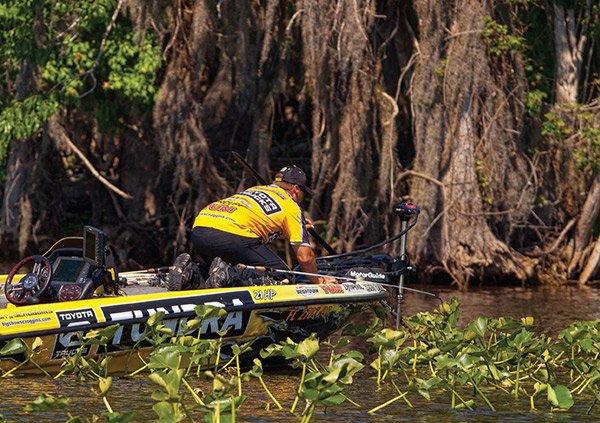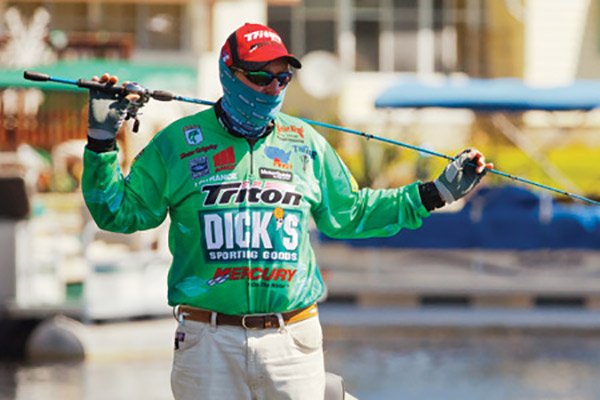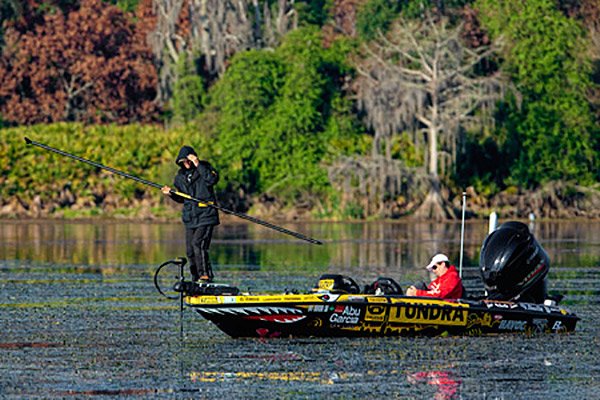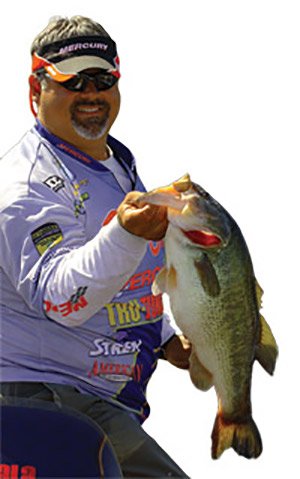Advertisement
Two of tournament fishing's best sight fishermen tell all about spawning bass.

Sometimes an angler bed fishing gets low to stay out of sight from an easily spooked fish, like Elite Series pro Terry Scroggins here.
Myth 1: Bass go deep in the winter.
Myth 2: Bass are only cover-oriented fish.
Myth 3: Early mornings and late afternoons are the best times to catch bass on topwaters.
For years these generalizations were steadfast rules in the annals of bass fishing literature. Then came modern-day bass tournaments with bohemian bassers who were willing to challenge and defy these standards of freshwater fishing. With tournaments we soon learned these "rules" were merely fishing myths, easily dispelled with hefty catches that took top prizes in the country's biggest tournaments.
Over the last 30 years, one fishing technique that has been mired in myth is that of sight fishing for bass on beds. Going into the 1980s it was still largely believed that bass on beds simply could not be caught. In addition, early convention held that the bass spawn was confined by strict parameters such as exact water temperatures, precise moon phases and specific areas. As a result, fishing for visible bedding bass remained untapped.
Sometime in the early 1980s two young pros from the state of Florida hit the B.A.S.S. trail and shattered these nesting notions. Shaw Grigsby and Peter Thliveros both forged very successful fishing careers with their ability to catch "uncatchable" spawning bass, and their names have become synonymous with the bass peeping technique.
While others believed bedding bass would not bite or the water was not warm enough for bass to spawn, Grigsby and Thliveros defied "logic" with huge catches of bass in springtime tournaments.
To this day, myths still abound about bedding bass, but these two sight fishing icons were willing to set the record straight for BoatUS. So you might want to heed the advice of these two piscatorial peepers and not necessarily believe everything you hear about bass on beds.
Myth: Bass on beds will not bite.
When initially encountering bass on beds, it's easy to see how this conclusion could be reached. When a boat first approaches or a lure is plopped down in a bed, bass flee the nest in a panic and do not return — at least not immediately. According to Grigsby, this is where patience becomes a premium for the angler and the waiting game begins. Backing off the beds, not casting and just watching is the trick. Many times within a 10-minute span, the bass will slowly return to the nest and begin to take a more defensive posture, patrolling the immediate area.
"So much of sight fishing is reading bass behavior," Grigsby explained. "At first it may look like the fish is "uncatchable" because it bolts away and appears not to return. But in time that fish will come back and its demeanor will change from fleeting to more patrolling and protective, in and around the bed. Once I see that, I know that bass is probably catchable. The only exception is when two fish are actually spawning. And by that I mean the male and female are actually bumping and rolling with each other — in those cases I have found the fish really will not bite. But if the eggs have been laid in the bed and a bass is there protecting them, at some point that fish will become defensive, and then aggressive, toward anything intruding on its turf."
Myth: If the bass can see you, it can't be caught.
"Absolutely not true," Thliveros said. "It's actually pretty amazing how quickly a bedding bass will get used to your presence. This is especially true if you stake your boat down in one spot, stay off your trolling motor and be very quiet. The idea is to become part of the landscape. Many times bass spawn around docks, behind reed heads or in hydrilla or pads.
Try to position your boat so you're next to the dock, pinned in the reed head or wedged into the thickest part of the vegetation. This way you 'blend' into objects the bass is already used to. But even if you're in a wide open flat with no protection, over time the bass will become immune to your presence – it may take longer, but they will get used to you being there."

Myth: Bass only spawn when the water temperature is between 68 and 72 degrees.
This big misconception is one Grigsby and Thliveros used to their advantage in tournament fishing. Early in their careers, both realized that bass began spawning much earlier than many believed. And they also discovered bass spawn much later, even into the summer, as well.
"Sixty degrees is plenty warm for bass to begin spawning," Grigsby revealed. "I've caught bass off beds anywhere from 58 to nearly 90 degrees — as early as December to as late as the Fourth of July and everywhere in between"
"Water temperature is just one of the factors that determines the spawn," Thliveros noted. "Moon phase, water level and water stability are all important factors, too. Personally, I believe the length of daylight hours increasing in the spring is what really triggers the spawning urge. Even if the water is still 55 degrees, if the days are getting longer, they want to make beds."
Both agree that river systems are also example of water temperatures taking a back seat to other forces such as water stability.
"Stable water is more of a premium in rivers," Grigsby added. "If the water temperature is only 58 or 59 and the water stabilizes, the fish are going to jump on that opportunity to get it done even though the "optimum" temperature has not been reached."
Myth: Bass only bed on the full moon.
"Make no mistake about it, the moon has a tremendous impact on the bass spawning cycle," Grigsby said. "But it's not always about the full moon. I've caught plenty of spawners between moons and on new moons as well."
"New moons can be just as good, if not better, than full moons," Thliveros offered.
Myth: Bass only bed in shallow water.
This is another convention that top bass pros would rather not see dispelled. While the masses troll the shallows looking for beds on the bank, many times the bedding bounty is actually right under their boat, or out behind them in 10, 15 or even 20 feet of water.
"On clear water lakes like Amistad or Beaver, bass will bed as deep as 20 feet," Grigsby said. "This is especially true later in the spring when deeper layers of water warm up. On clear, calm days when you can see down in the water, it's totally possible to sight-fish bass in 15 to 20 feet; they're actually less spooky because they have so much water over them and they feel safer."
"And don't think bass only bed on the bottom either," Thliveros said, busting another myth. "I've seen plenty of bass bed on dock braces or in the forks of branches in standing timber over 30 feet. You might be surprised just where bass can make beds."

Mike Iaconelli uses a push pole for a stealthy approach while searching for beds.
Myth: You must have clear water to bed fish.
While it might be true that you need clear water to actually sight fish, technically you don't need clear water to bed fish.
Thliveros is a master at "blind" bed fishing in darker or dirtier water where he cannot necessarily see the fish or the bed, but he knows both are present.
"In Florida bass will bed on pad roots, in arrowhead clumps or on isolated buggy whips," he said. "A lot times they give themselves away by just nipping or bumping a bait. Once I know a fish is there, I'll just keep pitching a lure to that particular pad or clump – almost dead-sticking it — until it bites."
"Watch the water for visual clues," Grigsby explained. "A lot of times defensive bedding bass will 'push' water to intimidate intruders or chase bluegills off the nest — that kind of commotion is a dead giveaway a bedding bass is around."
Myth: Bass beds are easy to spot.

Pro Angler J. Todd Tucker shields his eyes to
better see in the water.
Yes, in some Florida lakes, a bass bed is easy to recognize: it's usually a white, sandy 'bowl' in the bottom. But on many other lakes across the country, beds take on a variety of looks that are sometimes barely noticeable at all.
"I've fished all across the country and it always amazes how different bass beds look on different lakes," Grigsby described. "Some are light, sandy spots; some are sandy circles with dark, black centers; some are made on shells; in some Ozark lakes, they hardly have a bed at all, it will just be very lightly dusted off spot that's barely discernible from the rest of the bottom. So with each lake you fish, it's imperative that you see and understand what a bed looks like on that lake so you can train your eye on what to look for."
Myth: Sight fish can only be caught on light line, light weights and small baits.
For years it was believed that bedding bass were "line shy," because they often examine a lure very closely in the bed before biting it. In the last decade, however, it's been proven that braided line, heavy weights and big baits will often work just as well as a tiny tube tied to 8-pound test.
"Back in the good old days, bed fishing was a super-finesse game: the idea was to tease them into biting small," Thliveros said. "Nowadays it's become a game of aggravating and intimidating the fish into biting, triggering its reflexive defense. If a big tube keeps rushing the fish, it's eventually going to bite it to make it stop, no matter what size line it's tied to."
Myth: Only the male bass will bite, not the bigger females.

"Playing keep away from the male with a lure is
something that does require good visibility of the
fish." ~ Peter Thliveros
In most bedding-pair cases, the male is the most aggressive in terms of protecting the bed. Occasionally the female will be the more aggressive one and actually beat the male to the bait. But in order to have a better chance at catching the female, both pros agree that leaving the male — not catching it, even when it bites — is the best approach.
"Usually when the male is taken from the bed, the female leaves," Grigsby cautioned. "Occasionally, once the male is caught, the female will assume the defensive position in the bed and she can be caught, but it's rare. That's why I usually try to leave the male, shake him off when he bites in hopes that the female will eventually come in and take care of business. Even if a male bites over and over again, I'll forego the opportunity to catch it, leave it on the bed and come back at a later time to see if the female has changed demeanor in terms of aggressiveness. This trick has paid off more than once in tournaments."
"Playing keep away from the male with a lure is something that does require good visibility of the fish," Thliveros added. "You can't do this in limited visibility or darker water because you can't always readily tell which fish has the bait."
Myth: Bed fishing is unethical.
This one has been argued among anglers for years, but the bottom line is if you fish for bass in the spring, especially around shallow cover, chances are you are bed fishing whether you realize or not. "Pitching shallow bushes" may not sound as offensive as "bed fishing," but it's very likely bass in the bushes that can not be seen are spawning just the same as the ones you can see, making the question of ethics much broader.
"Some have said that sight-fishing should be outlawed," Thliveros opined. "I don't think the act of sight fishing alone should be outlawed, but I do believe that particular areas in lakes that are historically known as bass spawning grounds should be put off-limits to all fishing for a small time frame around the peak of the spawn to ensure some successful spawning activity."
Sight Fishing Record Setters

If you are looking to catch the biggest bass of your life, sight fishing might be the way to go.
Don't believe it? Consider that the heaviest single-day weight record for a five-bass limit on both the Bassmaster Elite Series and the FLW Tour have come from sight-fishing.
On Jan. 17, 2001, pro Dean Rojas caught a five-bass limit weighing an astounding 45 pounds, 2 ounces on Florida's Lake Toho – and he spied all of the behemoths before catching them.
On the FLW Tour side, Chad Prough hauled in 35 pounds, 3 ounces from Lake Okeechobee on Feb. 3, 2011 to set a record, and they all came sight-fishing as well.
Optical Options
So you have found some bass on beds, now what's the best lure to catch them with?
Sight fishing ace Peter Thliveros says if he could pick just one bed fishing lure it would be a 6-inch pumpkin lizard with a chartreuse tail, topped with a 3/16-ounce tungsten weight and tied to 15-pound fluorocarbon line on a casting rod.
Bassmaster Elite Series pro Shaw Grigsby says he can’t narrow his choice down to one single lure, but he's particular about one color that gives him high visibility.
"It would either be a tube, Rage Craw, or lizard," Grigsby offered."As for a color, white is usually my first choice. Match it with a ¼-ounce sinker and tie it to 17- to 20-pound fluorocarbon line on a casting rod and I'm good to go."
